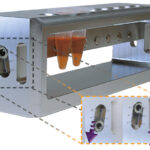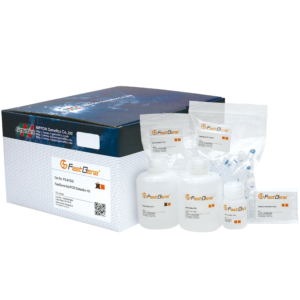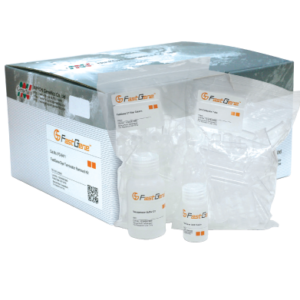Détails
Les billes magnétiques ont longtemps été utilisées pour isoler les acides nucléiques ainsi que les protéines recombinantes. La purification était cependant souvent problématique lorsque le culot était touché ou à cause d’une contamination quand le surnageant n’était pas complètement éliminé.
Le FastGene® MagnaStand résout ces deux problèmes. En créant un culot sur les parois latérales plutôt que vers le bas, le MagnaStand permet avec ses aimants puissants au néodyme de retirer complètement le surnageant sans toucher le culot.
De plus, avec le MagnaStand 1.5, la position verticale est réglable, ce qui permet d’ajuster précisément l’emplacement des aimants sur le tube en fonction du volume utilisé lors de la purification.
Aimants au néodyme pour une attraction plus rapide des particules magnétiques.
Les aimants au néodyme sont les aimants permanents les plus puissants au monde. Les avantages de l’utilisation de tels aimants sont les suivants :
- Séparation très rapide des billes magnétiques de la solution
- Culot stable même en cas de remise en suspension
- Collection complète des billes magnétiques pour moins de perte de matière
Avec la position verticale des aimants, la force magnétique vous donne la solution optimale pour la purification des billes magnétiques.
FastGene® 1.5 mL MagnaStand
- Effectuez jusqu’à 8 purifications en parallèle
- Aimants extra larges pour des volumes plus grands
- Ajustez la position de l’aimant au volume de votre échantillon
La position des aimants est ajustable horizontalement et verticalement.

Formats disponibles
Les supports Magna sont également disponibles pour :
- Tubes de réaction de 0,2 mL : FastGene® 0.2 mL MagnaStand (FG-SSMAG2)
- Plaques de 96 puits : FastGene® MagnaStand 96 (FG-SSMAG996)






Benjamin Reinhard, Genewerk GmbH Heidelberg –
Der Magnet ist seit mehr als einem Jahr im Dauerbetrieb und überzeugt durch seine robuste Verarbeitung, Magnetstärke, sowie die verstellbare Magnetschiene.
Deshalb haben wir uns auch noch den Magnastand 0,2 zugelegt.
Translated by NIPPON Genetics EUROPE:
The magnet has been in continuous operation for more than a year and impresses with its robust workmanship, magnetic strength and the adjustable magnetic rail. That’s why we also bought the Magnastand 0.2.
Utilisateur vérifié
S. Kaulfuß, Institut für Humangenetik Göttingen –
Wir verwenden sowohl den Magnastand 0,2 als auch den 1,5 für die Library-Präparation in unserer Routinediagnostik. Nach Austesten verschiedener Anbieter und auch eines Eigenbaus sind wir mit diesem Produkt hochzufrieden.
Translation from Nippon Genetics:
We use both the MagnaStand for 0.2 and 1.5 ml for the preparation of cDNA libraries. We are very satisfied with this product. Before using the MagnaStand we test several magnetic stands from other companies and a homemade magnetic stand.
Utilisateur vérifié
Marta Borowiec, PhD, Postdoctoral Fellow, University of Warsaw, Centre of New Technologies –
My research involves purifying DNA from a very small sample volume, often in a 96-well format. The first rack I had used a magnet in the form of an O-ring. Unfortunately, it did not work well below 50ul. The shape of the magnet also caused the problem since using it is convenient to support the tip of multichannel pipette on the PCR tubes. The Nippon magnet stands proved to be the perfect solution. Full mobility of the magnet holder makes it possible to adapt it to any volume and model of PCR tubes. In addition, it is possible to purify DNA from different sample volumes, thanks to individually fitted magnets. Another advantage is the possibility of firmly fixing the eppendorf (so that it does not fall out) and setting the entire stand in any position, even upside down. Since the whole stand is made of metal, it is very convenient to elute ssDNA from biotinylated DNA caught on streptavidin by heating the whole to 70°C.
And all this made me a happy owner of 3 different Nippon stands so far ?
Utilisateur vérifié
Herr Müller, Universität Göttingen –
Aufgrund seiner individuellen Einstellmöglichkeiten ist dieser robuste Magnetständer bei uns im Labor bei verschiedenen Applikationen im Einsatz. Alle Anwender sind sehr zufrieden. Klare Empfehlung
Translation by Nippon Genetics:
Due to its individual setting options, this robust magnetic stand is used by us in the laboratory for various applications. All users are very satisfied with it. I can absolutely recommend this product.
Utilisateur vérifié
Lab Manager, Universität Basel –
„Actually Postdoc using it is truly happy with it, she will recommend to anybody will ask“.
Utilisateur vérifié
Herr Gossenreiter, Max F. Perutz Laboratories, Wien –
„Wir haben verschiedene magnetic racks für PCR-tubes verglichen und der FastGene® MagnaStand 0.2 hat uns mit seiner Robustheit, Magnetstärke, Justierbarkeit und dem guten Halt der PCR-tubes überzeugt.“
Utilisateur vérifié
Frau Dr. Rost, Institut für Humangenetik, Würzburg –
„Der Magnetständer FastGene® MagnaStand 0.2 der Firma Nippon Genetics wird im Diagnostik-Labor unseres Instituts für das SureSelectQXT Target Enrichment (Agilent) von genomischer Patienten-DNA zur Sequenzierung am MiSeq (Illumina) verwendet. Bei folgenden Schritten wird der Magnetständer eingesetzt: während der beiden Aufreinigungsschritte der Library mittels AMPure XP Beads, während der „Capture“-Schritte der hybridisierten DNA mittels Streptavidin-coated Magnetic Beads (Dynabeads von Life Technologie), sowie während der finalen Aufreinigung der amplifizierten Library mittels AMPure XP Beads. Zusammenfassend wird der Magnetständer folglich in jedem Schritt eingesetzt, in dem entweder AMPure Beads oder Dynabeads verwendet werden. Die Dynabeads lassen sich etwas schlechter trennen als die AMPure Beads, aber dieses Problem scheint unabhängig vom verwendeten Magnetständer aufzutreten.“
Translation by Nippon Genetics
“The magnetic stand FastGene® Magna Stand (FG-SSMAG2) from Nippon Genetics was implemented in the diagnostic lab of our institute to isolate genomic DNA from patients, for a SureSelectQXT Target Enrichment (Agilent), before being sequenced using a MiSeq instrument (Illumina). The FastGene® Magna Stand has been used in all steps where AMPure XP beads (BeckmanCoulter) or Dynabeads (Life Technology) were utilized.
The handling of the FastGene® Magna Stands is very easy and the results obtained so far are good. The pellet stays, as desired, at the side of the tube wall, enabling an easy removal of the supernatant. In some cases, the complete removal of the elution was possible. The FastGene® Magna Stand is compact and robust. We are very satisfied with it and would recommend it any time!”
Utilisateur vérifié
Dr. Yohei Sasagawa, Bioinformatische Forschungsanlage, Rechen- und Kommunikationszentrum, RIKEN, Japan –
“More and more applications are performed using magnetic beads, so that a magnetic stand is required which can handle very small volumes. Especially in the genomics research field, where massively parallel sequencing is performed, it is essential for an ideal magnetic stand that is used for the purification of DNA and RNA, to be compatible with a variety of commercially available PCR tubes and plates.
The available magnetic stands could not capture the magnetic beads firmly or provide an easy handling for the researcher. The handling of the FastGene® MagnaStands is easy, without any loss of magnetic beads during purification even when very few µl of liquid volume were used. Hence, it is the solution for the well-known and common problem of sample loss due to magnetic beads being aspirated by the pipette during a purification using a small sample volume.
The FastGene® MagnaStand 0.2 and the FastGene® MagnaStand 1.5 can be used for the purification of small number of samples.
The FastGene® MagnaStand 96 is useful for the purification of a large number of samples, e.g. for single-cell genomic research.
All FastGene® MagnaStands are the best tool to easily purify magnetic beads from small volumes, since the magnetic beads are firmly held in one position of the tube wall.”
Translation by Nippon Genetics
„Immer mehr Applikationen werden mit Hilfe von Magnetic Beads durchgeführt, so dass Magnetische Stands benötigt werden, die auch sehr kleine Volumen händeln können. Besonders im Bereich der genomischen Forschung, in der äußerst viele parallele Sequenzierungen durchgeführt werden, sind für die DNA und RNA Aufreinigung benutzte magnetische Stands essentiell, die kompatibel mit diversen kommerziell erhältlichen PCR Reaktionsgefäßen und Platten sind.
Die bisher erhältlichen Magnetic Stands konnten die Magnetic Beads nicht gänzlich erfassen oder waren nur schwer bedienbar. Die Handhabung von FastGene® MagnaStands ist einfach und Magnetic Beads gehen während der Aufreinigung nicht einmal dann verloren, wenn nur wenige µl Flüssikeit verwendet werden. Somit sind sie die Lösung für das altbekannte, häufig auftretende Problem des Probeverlustes durch das Einsaugen der Magnetic Beads mit der Pipette bei der Verwendung geringer Probevolumen.
Das FastGene® MagnaStand 0.2 und das FastGene® MagnaStand 1.5 kann für die Aufreinigung einer kleinen Anzahl von Proben verwendet werden.
Das FastGene® MagnaStand 96 ist nützlich für die Aufreinigung einer großen Anzahl von Proben, z.B. für eine Single cell Genomsequenzierung.
Alle FastGene® MagnaStands sind die besten Arbeitshilfen zum Reinigen von Magnetic Beads, die in geringen Volumen vorliegen, da die Magnetic Beads fest in einer Position an der Wand des Raktionsgefäßes gehalten werden.
Dr. Yohei Sasagawa ist ein Forscher der in Zusammenarbeit mit Nippon Genetics die FastGene® MagnaStands für seine NGS Library Präparation entwickelt hat.
Utilisateur vérifié